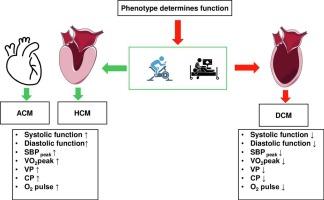Incidence of cardiovascular risk factors and exercise phenotyping in cardiomyopathies: One size does not fit all
IF 2.5
Q2 CARDIAC & CARDIOVASCULAR SYSTEMS
引用次数: 0
Abstract
Background
Cardiovascular disease risk factors (CVDRF) are linked to increased morbidity in cardiomyopathies (CMP), but whether new onset CVDRF differ among CMPs is unknown. In addition, whether the acute exercise response during cardiopulmonary exercise testing (CPET) differs among CMPs remains unclear.
Methods
This single-center, retrospective study analyzed patients with arrhythmogenic, hypertrophic, and dilated (DCM) cardiomyopathy without CVDRF at baseline. Resting echocardiography and CPET were performed, and exercise response was assessed depending on sex and CMP. After a median follow-up of 19.5 months, CPET and echocardiography were analyzed in relation to the development of new CVDRF.
Results
A total of 104 CMPs were included (median age 53.0 years). New-onset CVDRF was rare (11.5 %) and driven by arterial hypertension (8.7 %) but did not differ among CMPs. DCM displayed significantly lower resting left ventricular ejection fraction (40.5 %, interquartile range, IQR, 11.5 %, p < 0.001), diastolic function (E/e‘ 9.3, IQR 5.5, p < 0.001), and had the lowest peak systolic blood pressure (170.0 mmHg, IQR 52.5 mmHg, p = 0.011), predicted peak oxygen consumption (82.0 %, IQR 39.8 %, p = 0.003), oxygen pulse (101.0 %, IQR 28.8 %, p = 0.030) as well as lower ventilatory (VP, 5.5 mmHg, IQR 1.4 mmHg, p = 0.033) and circulatory (CP, 4096.0 mL/kg/min x mmHg, IQR 2299.3 mL/kg/min x mmHg, p = 0.015) power compared to the other groups. Lower VP (5.0 mmHg, IQR 1.3 mmHg, p = 0.003) and CP (3660.0 mL/kg/min x mmHg, IQR 3298.0 mL/kg/min x mmHg, p = 0.004) were observed for females.
Conclusions
Arterial hypertension was the most common CVDRF among CMPs, underscoring the importance of monitoring this outcome. Exercise limitations differ between CMPs and should be interpreted depending on sex.

心肌病中心血管危险因素的发生率和运动表型:一个大小不适合所有
背景:心血管疾病危险因素(CVDRF)与心肌病(CMP)发病率增加有关,但新发CVDRF在CMP中是否存在差异尚不清楚。此外,心肺运动试验(CPET)期间的急性运动反应在cmp之间是否存在差异尚不清楚。方法该单中心回顾性研究分析了基线时无CVDRF的致心律失常、肥厚和扩张型(DCM)心肌病患者。进行静息超声心动图和CPET检查,并根据性别和CMP评估运动反应。中位随访19.5个月后,分析CPET和超声心动图与新发CVDRF的关系。结果共纳入cmp 104例,中位年龄53.0岁。新发CVDRF罕见(11.5%),由动脉高血压(8.7%)驱动,但在cmp中没有差异。DCM表现出较低的静息左室射血分数(40.5%,四分位间距,IQR, 11.5%, p <;0.001),舒张功能(E/ E 9.3, IQR 5.5, p <;0.001),收缩压峰值(170.0 mmHg, IQR为52.5 mmHg, p = 0.011)、预测耗氧量峰值(82.0 %,IQR为39.8%,p = 0.003)、氧脉冲(101.0 %,IQR为28.8%,p = 0.030)以及较低的通气(VP, 5.5 mmHg, IQR为1.4 mmHg, p = 0.033)和循环(CP, 4096.0 mL/kg/min x mmHg, IQR为2299.3 mL/kg/min x mmHg, p = 0.015)功率。女性的VP (5.0 mmHg, IQR为1.3 mmHg, p = 0.003)和CP (3660.0 mL/kg/min × mmHg, IQR为3298.0 mL/kg/min × mmHg, p = 0.004)较低。结论原发性高血压是cmp中最常见的CVDRF,强调了监测这一结局的重要性。运动限制因cmp而异,应根据性别来解释。
本文章由计算机程序翻译,如有差异,请以英文原文为准。
求助全文
约1分钟内获得全文
求助全文
来源期刊

IJC Heart and Vasculature
Medicine-Cardiology and Cardiovascular Medicine
CiteScore
4.90
自引率
10.30%
发文量
216
审稿时长
56 days
期刊介绍:
IJC Heart & Vasculature is an online-only, open-access journal dedicated to publishing original articles and reviews (also Editorials and Letters to the Editor) which report on structural and functional cardiovascular pathology, with an emphasis on imaging and disease pathophysiology. Articles must be authentic, educational, clinically relevant, and original in their content and scientific approach. IJC Heart & Vasculature requires the highest standards of scientific integrity in order to promote reliable, reproducible and verifiable research findings. All authors are advised to consult the Principles of Ethical Publishing in the International Journal of Cardiology before submitting a manuscript. Submission of a manuscript to this journal gives the publisher the right to publish that paper if it is accepted. Manuscripts may be edited to improve clarity and expression.
 求助内容:
求助内容: 应助结果提醒方式:
应助结果提醒方式:


